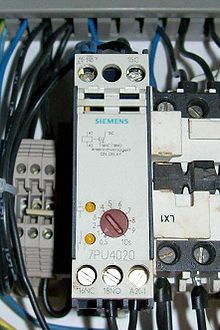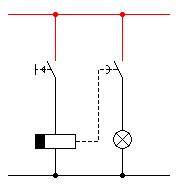Timing relay

As a timing relay , a combination of a relay and a timing element is called, with the help of which u. a. Switch-on or switch-off delays can be achieved in control and automation technology .
Executions
Time relays are available in the following versions:
- electromechanical
-
- a direct current or synchronous motor actuates adjustable switch contacts via a reduction gear
- a pneumatic, aerodynamic or thermal timing element or a clockwork completes the delay
- electronically
- an electronic circuit serves as a timer
- (historically) an analog circuit with an RC element as a timer and a comparator or the relay itself as a trigger
- a digital circuit with an oscillator, frequency divider, counter and comparator, mostly as a multifunction relay with a microcontroller
Timing relays are designed for a specific time range, which can range from seconds to hours and can often be selected in powers of ten.
The setting accuracy and delay time of digital time relays are e.g. B. quantized with 0.1 seconds, this absolute accuracy does not depend on the total time as with analog devices.
Multi-function time relays offer a selection of common time functions via a built-in selector switch. (e.g. on- delayed, off-delayed, wiping on make, wiping off, clocking, pulse-forming)
Applications
By interconnecting several timing relays, automatic sequential circuits can be implemented ( connection-programmed controls ). Typical applications for timing relays are e.g. B .:
- Automatic start-up controls for motors (e.g. star-delta switching )
- Minute light , staircase time switch or automatic staircase light (called minute track in Switzerland )
- Fan control (run-on relay), often with response and release delay in the same circuit
- Traffic light controls
- Elevator controls
- Exposure clock
For complex control tasks, timing relays and connection-programmed controls are rarely used today and are mostly replaced by programmable logic controllers (PLC).
See also
literature
- Theodor Schmelcher: Handbook of Low Voltage: Project planning information for switchgear, switchgear and distribution boards. Siemens, Berlin / Munich 1982, ISBN 3-8009-1358-5
- Electrical engineering expertise. 27th, revised and expanded edition. Verlag Europa-Lehrmittel, Haan-Gruiten 2009, ISBN 978-3-8085-3188-4

